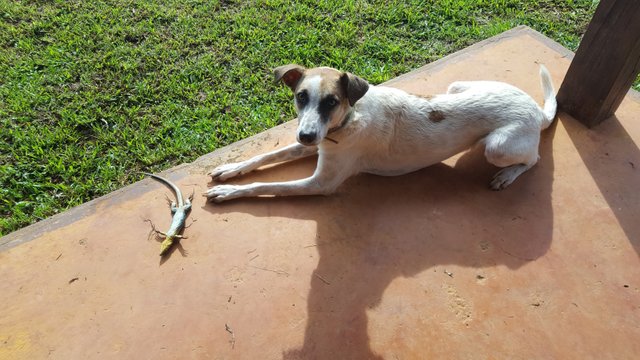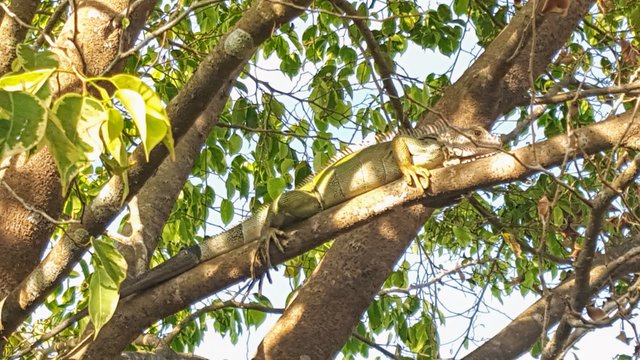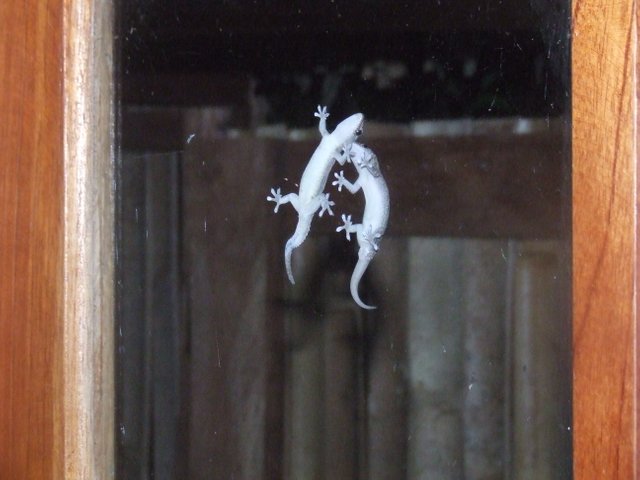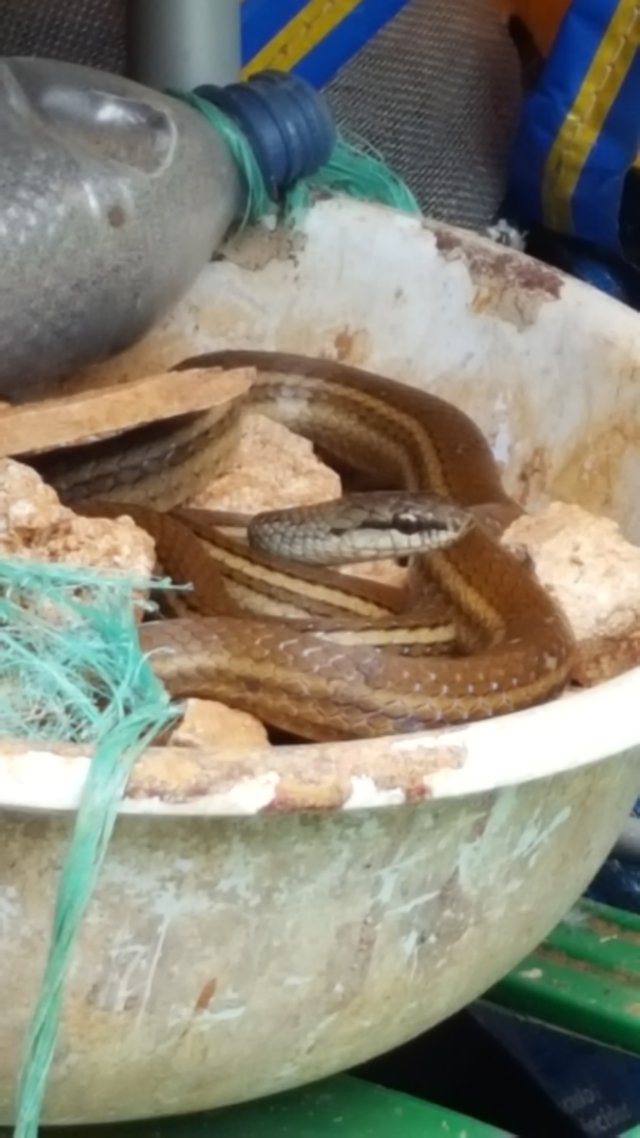Molly the dog and Panama Reptiles - [ENG/ITA]

Molly, the killer
English is not my first language, so please feel free to correct me or suggest any advice!
Tonight I had a nightmare that suddenly woke me up. At that point I had to try to shift my attention to something else and not just to the image seen in my dream. Moreover, I believe in the energy of the universe and its laws, like that of creation and I believe that thoughts are energy; therefore, by focusing insistently on something, I think that eventually something can materialize. This usually leads me to drive evil thoughts out of my mind.
I dreamed that a big python was crushing my dog Molly. Probably because a few days ago we found a viper in our veranda, under a sofa near which some guests had been until a few minutes before. I never thought about starting the adventure on Steemit with a snake post, especially because they are one of the few categories of animals that I do not like. But it seems that this post chose me.
I was saying that we found this little viper, rolled up on itself between the leg of the sofa and our house wall. Both my husband and I are not at all comfortable in these circumstances, for which, in the past, we have called a neighbor or a friend fireman.
This time we managed to get by on our own and suppress it. I do not think it's a nice gesture, but a specimen of this kind, even more if it is small, is very dangerous to keep in the property.
.jpg)
Wikimedia Author Brian Gratwicke
I would therefore like to show you some of the local fauna, especially some Panama reptile.
Panama is one of those countries, as well as Australia, where if you read what are the dangers, you decide that it is better not to visit. In fact, living here for more than eight years, I can say that the important thing is to be careful where you put your hands and feet, especially when it's dark. We would have seen a dozen of them all these years, but every time you get chills, thinking about how many times you have not paid enough attention to do some work in the yard.
Panama offers a wide selection of dangerous reptiles.
The viper I'm talking about is called Terciopelo, a close relative of Fer de Lance, with whom he is often mistaken. Known by locals as Vibora X (equis), for the x-pattern that is repeated on its body, it is very aggressive and poisonous, but today with the availability of antidotes, mortality in case of bite is almost nothing. This type of viper is responsible for most snake bites in Central America. Active mainly at night, meeting it in daylight guarantees a lower lucidity of the reptile.
Fortunately, even an animal so aggressive, has some predator including another snake: The Mussurana. We did not know it existed, until one evening we found this "scary" fire red reptile in our yard, with our cat Morena quietly sitting by its side. Perhaps this should have already made us sense something. However, in the grip of terror, we call our neighbour. This man, recognising the serpent as the ferocious Candela (Flame), kills him with his unmissable machete. After some time, the episode repeated with another specimen, ending again with that efferate gesture towards the reptile. At that point, we had a doubt.
But are we sure that what the neighbour said is true?
In Panama locals often do not go for the thin, snake is snake. So we questioned our vet who revealed the mystery: not only the Mussurana (at that time we did not know the name, we had not found anything on the internet looking red snake) was not dangerous, but it was even a predator of vipers! Oh God, we had sacrificed at least two specimens in vain, depriving us of important allies from the animal kingdom. Since then, of course, Clelia Clelia, this is its official name, was never touched again. Actually, it would be a beautiful snake, if you liked that kind: its back is completely red solid color with white belly and purple head. In reality, this is the coloration of young specimens that as adults become blue / black. Maybe that's why we did not find information easily. Anyway ... God save the Mussurana!
_juvenile_(38529892202).jpg)
Wikicommon Author Bernard Dupont
Another widespread reptile in Panama is the Boa Constrictor, the protagonist of my dream. It is not aggressive and generally does not attack humans, but one of its bites is very painful and infectious, though not poisonous. It crushes its prey to kill them, as everybody knows. He loves to be hidden among the trees during the day, and then hunting at night. Unfortunately, like almost everything that moves, here it is generally killed.
I was forgetting the most feared of all, the Coral snake. His fame as a lethal killer, however, is undeserved, because due to its small size and its low aggressiveness, this reptile avoids any contact with human beings and tries to find an escape if he feels threatened. Coral is a diurnal snake, unlike many others: in Panama there are 9 types, but the most numerous is the common Coral,Micrurus nigrocinctus, which has yellow, red and black bands. Then there are the fake Coral, which have the same colors but in a different order.
How to recognize them?
An acronym comes to help us and it’s easy to remember: RANA, given by the sequence of its colors in Spanish (rojo, amarillo, negro, amarillo, red, yellow, black and yellow in English): yellow can be white in some cases. This is the only sequence that characterizes the original snake, easy to recognize. There are, however, exemplars with only 2 colors, which makes the distinction a bit 'more complex ... Better stay away anyway!
_(6955307478).jpg)
WikipediaBy J. Paulo Carbajal-Borges
Turning to some other kind of reptile a little less disturbing, I can say that in Panama, as in many tropical countries, there is a very high concentration of Geckos. They are everywhere and poop agog. Every day you find their souvenirs here and there. The difference compared to European geckos is that they emit sounds, like a repeated pop, with the tongue, I guess, like when you call a cat. An Italian guest, a long time ago, after having heard it, asked: "What is this satanic laugh?"
After them come the coloured lizards, called Lagartija with dyes on the back that tend to blue. They run very fast, especially when Molly chases them. Unfortunately, it occasionally catches one.
Finally here I am talking about the Iguanas: there are not many around, no need to say why, but, although there is a law that protects them, locals say they taste like chicken...
Since our property has been transformed from an arid rectangle to a small garden of fruit trees surrounded by Hibiscus and Bougainvillea, the iguanas slowly began to come. They are always hidden in the branches of the fence trees, because of the evil little dog that has already killed a couple. Most are young, bright green. Only a few adults come.
.jpeg)
The place where there are most Iguanas is incredibly the central square of David, the second largest city in Panama. In this small park in the middle of a busy crossroads they are considered untouchable and are fed with lettuce and remains of various foods, so that they find themselves overweight and not able to easily climb on the surrounding trees. They share the food offerings of passers-by and the garden beds with pigeons and squirrels, which are thin and black here.

Speaking of reptiles of increasing size, I cannot talk about Totto.
Totto is a Crocodile, who lives in a river in the property of a couple of Panamanian friends. The first time they told us about him, we did not believe it. They took us to that river, which has a raised embankment, and they began to call it by name. Suddenly, at the call, the waters moved and a dark figure appeared, getting closer and closer to the shore. It was him, the domestic crocodile (they discovered later it was a she)!
The reptile was so used to being rewarded with some succulent piece of meat, to respond to every call, but the scene of his arrival has left us speechless!
Well, I would say that with this I can conclude. As already mentioned, this is a post "a bit 'all and a bit' nothing", arose from a nightmare. I hope I have not bored you with this totally unexpected article.
All images and videos are mine except where specified
Source
https://www.diaadia.com.pa/etcetera/las-serpientes-de-coral-183404
http://panamasilvestre.blogspot.com/2011/08/boa-constrictor-boidae.html
https://it.wikipedia.org/wiki/Clelia_clelia
https://en.wikipedia.org/wiki/Bothrops_asper
ITALIANO
Stanotte ho avuto un incubo che mi ha svegliato all’improvviso.
A quel punto dovevo cercare di spostare l’attenzione su qualcos’altro e non solo sull’immagine vista in sogno. Oltretutto, credo nell’energia dell’universo e nelle sue leggi, come quella di creazione e credo che i pensieri siano energia; per questo, focalizzandosi insistentemente su qualcosa, penso che alla fine questo qualcosa si possa materializzare. Ciò mi induce solitamente a scacciare dalla mente pensieri malevoli.
Ho sognato che un pitone bello grande stava stritolando la mia cagnolina Molly.
Probabilmente perché qualche giorno fa abbiamo trovato una vipera in veranda, sotto a un divano vicino al quale erano stati degli ospiti fino a qualche minuto prima. Non avrei mai pensato di iniziare l’avventura su Steemit con un post sui serpenti, anche perché sono una delle poche categorie di animali che non amo. Ma pare che questo post abbia scelto me.
Dicevo che abbiamo trovato questa viperetta, piccola, arrotolata su se stessa tra la gamba del divano e il muro di casa. Sia io che mio marito non siamo per niente a nostro agio in queste circostanze, motivo per il quale, in passato, abbiamo chiamato un vicino o un amico pompiere.
Questa volta siamo riusciti a cavarcela da soli ed a sopprimerla. Non credo sia un bel gesto, ma un esemplare del genere, ancor di più se è di dimensioni ridotte, risulta essere molto pericoloso da tenere in giardino.
.jpg)
Wikimedia Autore Brian Gratwicke
Vorrei quindi illustrarvi parte della fauna locale, in particolare i rettili di Panama.
Panama è uno di quei paesi, come pure l’Australia, in cui se ti fermi a leggere quali sono i pericoli, decidi che è meglio non visitare. In realtà, vivendo qui da più di otto anni, posso dire che l’importante è stare attenti a dove si mettono mani e piedi, specialmente quando è buio. Noi ne avremmo viste una decina in tutti questi anni, ma in ogni occasione ti vengono i brividi, ripensando a quante volte non hai prestato sufficiente attenzione nel fare qualche lavoro all’aperto.
Panama offre una vasta scelta di rettili pericolosi.
La vipera di cui vi sto parlando si chiama Terciopelo, parente stretto del Fer de Lance, con cui viene spesso scambiato. Conosciuta in loco come Vibora X (equis), per il disegno a x che si ripete sul suo corpo, è molto aggressiva e velenosa, ma oggi con la disponibilità di antidoti, la mortalità in caso di morso è quasi nulla. Questa tipologia di vipera è responsabile della maggior parte dei morsi di serpente in America Centrale.
Attiva prevalentemente di notte, incontarla alla luce diurna garantisce una minore lucidità del rettile.
Per fortuna, anche un animale così aggressivo, ha qualche predatore tra cui un altro serpente: Il Mussurana.
Noi non ne conoscevamo l’esistenza, fino a quando una sera ci siamo trovati questo “ spaventoso” rettile rosso fuoco in giardino, con la nostra gatta Morena tranquillamente seduta al suo fianco. Forse questo avrebbe già dovuto farci intuire qualcosa. Comunque, in preda al terrore, chiamiamo il vicino di casa. Costui, riconoscendo il serpente come il feroce Candela, lo uccide brandendo il suo immancabile machete. Dopo qualche tempo, l’episodio si ripete con un altro esemplare, concludendosi nuovamente con quel gesto efferato nei confronti del rettile. A quel punto, ci sorge un dubbio.
Ma siamo sicuri che quello che ha detto il vicino sia vero?
A Panama spesso non si va per il sottile, serpente è serpente.
Interrogammo quindi il veterinario di zona che ci rivelò l’arcano: non solo il Mussurana (ai tempi non conoscevamo il nome, non avevamo trovato nulla su internet cercando serpente rosso) non era pericoloso, ma era addirittura un predatore di vipere! Ahinoi, avevamo sacrificato almeno due esemplari inutilmente, privandoci di importanti alleati del regno animale.
Da allora, ovviamente, il Clelia Clelia, questo il suo nome ufficiale, non si tocca.
Anche se vedere da vicino un essere strisciante ci mette sempre paura! Che poi, sarebbe anche un bel serpente, se ci piacesse il genere: ha il dorso completamente rosso tinta unita con la pancia bianca e la testa violacea. In realtà, questa è la colorazione dei giovani esemplari che da adulti diventano blu/nero. Forse è per questo che non trovammo informazioni facilmente. Comunque...Dio salvi il Mussurana!
_juvenile_(38529892202).jpg)
Wikicommon Autore Bernard Dupont
Altro rettile diffuso a Panama è il Boa Constrictor, il protagonista del mio sogno. Non è aggressivo e generalmente non attacca l’uomo, ma un suo morso è molto doloroso e infettivo, sebbene non velenoso. Stritola le sue prede per ucciderle, come è noto. Ama stare nascosto tra gli alberi durante il giorno, per poi cacciare la notte. Purtroppo, come quasi tutto quello che si muove, qui viene generalmente ucciso.
Stavo dimenticando lo spauracchio per eccellenza in questo campo, il serpente Corallo.
La sua fama di letale assassino è però immeritata, visto le sue ridotte dimensioni e la sua scarsa aggressività che lo porta ad evitare il contatto con gli esseri umani ed a trovare una via di fuga in caso si senta minacciato.
Il Corallo è un rettile diurno, a differenza di molti altri: a Panama ce ne sono 9 tipi, ma il più numeroso è il Corallo comune, Micrurus nigrocinctus, che presenta bande colorate gialle, rosso e nero. Ci sono poi i finti Corallo, che hanno gli stessi colori ma in un ordine differente.
Come riconoscerli?
Ci viene in soccorso un acronimo, facile da ricordare: RANA, dato dalla sequenza dei colori in spagnolo (rojo, amarillo, negro, amarillo ossia rosso, giallo, nero e giallo): il giallo può essere bianco in alcuni casi. Questa è l’unica sequenza che caratterizza il serpente originale,facile da riconoscere.
Ne esistono però esemplari con solo 2 colori, che rende il distinguerli un po’ più complesso...Facciamo che ce ne teniamo alla larga in ogni caso, senza sapere nè leggere nè scrivere, come si suol dire.
_(6955307478).jpg)
WikipediaBy J. Paulo Carbajal-Borges
Passando a qualche altro tipo di rettile un po’meno inquietante, posso dire che a Panama, come in molti paesi tropicali, c’è un’altissima concentrazione di gechi. Sono ovunque e cagano a profusione. Ogni giorno trovi i loro ricordini qua e là. La differenza rispetto ai gechi europei è che emettono dei suoni, tipo uno schiocco ripetuto, con la lingua, immagino, tipo quando chiami il gatto.
Un’ospite italiana, tanto tempo fa, dopo averlo sentito, chiese: “ Cos'è questa risata satanica?”
Dopo di loro vengono i lucertoloni colorati, chiamati Lagartija con tinte sul dorso che tendono all'azzurro. Corrono molto veloci, soprattutto quando Molly le rincorre. Purtroppo ogni tanto ne acchiappa una.
Finalmente eccomi a parlare delle iguane: non ce ne sono moltissime in giro, non credo vi debba dire il perché, ma, sebbene ci sia una legge che le protegge, dicono che sanno di pollo...
Da quando il nostro terreno si è trasformato da arido rettangolo a un piccolo giardino di alberi da frutta circondato da Hibiscus e Bougainvillea, le iguane hanno iniziato lentamente a palesarsi. Stanno sempre nascoste tra i rami della siepe, sempre per colpa della cagnolina malefica che ne ha già accoppate un paio. La maggior parte sono giovani, verde brillante. Solo di rado ne spunta qualcuna adulta.
.jpeg)
Incredibilmente il luogo in cui c’è il maggior numero di iguane è la piazza centrale di David, la seconda città di Panama per importanza. In questo piccolo parco al centro di un trafficato crocevia sono considerate intoccabili e vengono nutrite a insalata e resti di cibo vario, cosicché si ritrovano in sovrappeso, tanto da non riuscire ad arrampicarsi agevolmente sugli alberi circostanti.
Condividono le offerte alimentari dei passanti e le aiuole del giardino con piccioni e scoiattoli, che qui sono magri e neri.

Occupandomi ora di rettili di dimensione crescente, non posso che parlare di Totto.
Totto è un coccodrillo, che vive in un fiume nella proprietà di una coppia di amici panamensi. La prima volta che ci hanno raccontato di lui, non ci credemmo. Ci portarono al fiume, che ha un argine rialzato, e iniziarono a chiamarlo per nome. Improvvisamente, al richiamo, le acque si mossero e una figura allungata apparve, avvicinandosi sempre di più alla riva. Era lui, Il coccodrillo domestico (che in seguito scoprirono trattarsi di una lei)!
Il rettile era talmente abituato ad essere omaggiato con qualche pezzo succulento di carne, da rispondere ad ogni richiamo, ma la scena del suo arrivo ci ha comunque lasciato a bocca aperta!
Beh, direi che con questo posso anche concludere. Come già anticipato, eccovi un post “un po’ tutto e un po’ niente” , scaturito da un incubo.
Spero di non avervi annoiato con questo articolo del tutto inatteso.
Tutte le immagini e i video sono di mia proprietà, eccetto dove specificato diversamente
Fonti
https://www.diaadia.com.pa/etcetera/las-serpientes-de-coral-183404
http://panamasilvestre.blogspot.com/2011/08/boa-constrictor-boidae.html
https://it.wikipedia.org/wiki/Clelia_clelia
https://en.wikipedia.org/wiki/Bothrops_asper

Congratulazioni!
Hai appena ricevuto il voto del trail di @steemit-italia***
Se vuoi, puoi informarti sul nostro progetto qui e partecipare anche tu al trail, ottenendo il beneficio di poter ricevere gratuitamente il voto sui tuoi post una volta al giorno!Clicca sul banner per entrare sul nostro server discord!
Delega a Steemit-Italia: 50SP |100 SP |500 SP| 1000 SP
Ben vengano questi post “un po’ tutto e un po’ niente”!!! È stato molto interessante leggerti!
Grazie per aver letto e commentato!
Santo cielo che bestie!!! Queste si che ti possono fare venire gli incubi, poi sapendo che si avvicinano così a casa, avrei il terrore di trovarmeli nel letto. Bel post informativo comunque, ci hai messo in guardia nel caso dovessimo passare per Panama!
Un po' ti ci abitui. Pensa che in uno dei primi viaggi, alle Maldive in quel caso, solo la vista dei gechi in bagno mi terrorizzava :D e di notte deliravo! Avere 3 cani in giardino e un gatto in camera comunque mi rende tranquilla. Grazie per il commento!
Accipicchia, i rettili mi piacciono li trovo belli, forti e colorati e anche molto strani. Ma come molti animali mi rendo conte che possono essere pericolosissimi e che non sia per nulla piacevole trovarseli in casa o a pochi metri.
Grazie per le dritte al riguardo!
Io non posso proprio farmi piacere i serpenti! Il resto sì, ma quelli... Questo era sotto una finestra: erano 2 anzi! Una regola fondamentale che non ho scritto è: non tenere cataste di legna, cianfrusaglie o qualsiasi cosa in cui si possano annidare.

Maledizione. Sono veramente dei teppistelli! Mmh ok io sarei spacciata a casa mia... 😱😰
Un vero e proprio reportage sul mondo rettile e non, di quel di Panama. Pure io al vostro posto ne sarei terrorizzato anche per il fatto che avete un micio che vaga per il giardino. Dei gechi però si dice che portano fortuna. Complimenti per questo bel post!
Posted using Partiko Android
Il micio quasi non esce più, ma per paura di Molly! Pare che i gatti comunque vedano i movimenti dei serpenti come se fossero rallentati, quindi che possano difendersi e ferirli con facilità, ma spero di non appurarlo mai con i miei occhi. I gechi ormai fanno parte della famiglia, l'unico problema sono le cacate continue :D Grazie dell'apprezzamento Nicola!
Mamma mia che bel post! Davvero esaustivo, preciso e ben fatto! Come esordio su steemit lo definirei col botto!!! B R A V I S S I M A
Mi associo con Dave... Bello, tutto da leggere. Bravissima
Un saluto, nicola
Posted using Partiko Android
Grazie del riconoscimento @mondodidave73!
Grazie anche a te Nicola.
Posted using Partiko Android
This post has been voted on by the steemstem curation team and voting trail.
There is more to SteemSTEM than just writing posts, check here for some more tips on being a community member. You can also join our discord here to get to know the rest of the community!
Hi @akireuna!
Your post was upvoted by utopian.io in cooperation with steemstem - supporting knowledge, innovation and technological advancement on the Steem Blockchain.
Contribute to Open Source with utopian.io
Learn how to contribute on our website and join the new open source economy.
Want to chat? Join the Utopian Community on Discord https://discord.gg/h52nFrV
Congratulations @akireuna! You have completed the following achievement on Steemit and have been rewarded with new badge(s) :
Click on the badge to view your Board of Honor.
If you no longer want to receive notifications, reply to this comment with the word
STOP